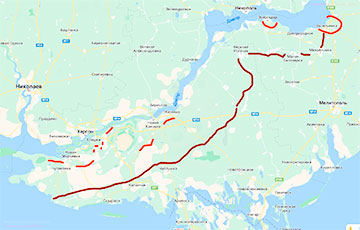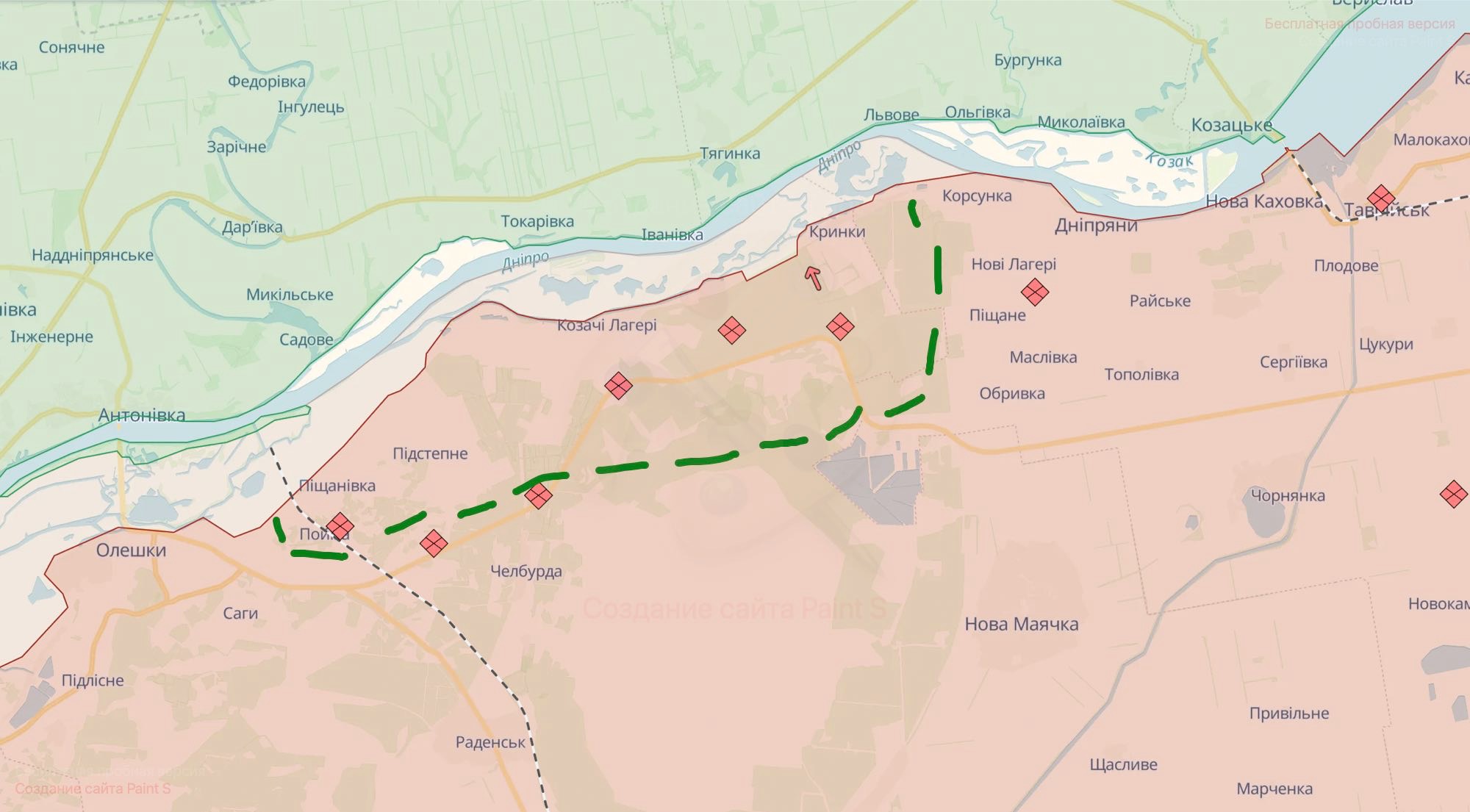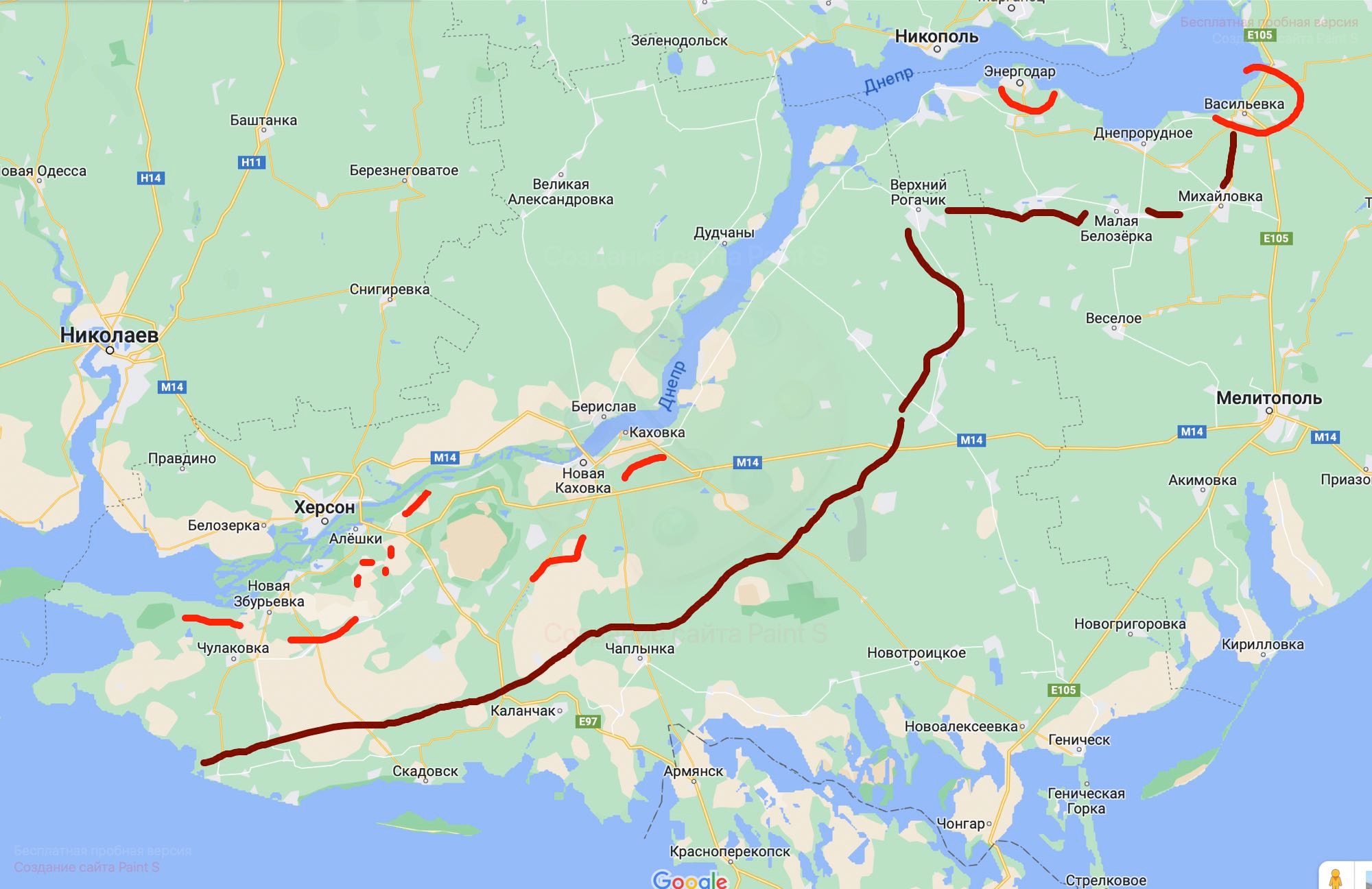Teplinsky’s Plan: Russia Preparing Large-Scale Retreat In Kherson Region
9- 18.11.2023, 18:41
- 40,334

The occupiers are unable to hold the front along the Dnipro river.
The left bank of the Kherson region is the only place on the line of combat contact where there is currently no continuous front, write the authors of the Volya Telegram channel.
After the defeat in the Kharkiv region, which occurred in September 2022, Russian troops formed a continuous front from the Belgorod region to Kreminna (Kupyansk and Krasnolymansk directions). In the spring and early summer, a front took shape from Bilohorivka to Bakhmut and Kurdyumivka and from Horlivka to Vuhledar.
At the beginning of summer, through the efforts of Russian general Mikhail Teplinsky, now the commander of the Dnepr group, a continuous front was formed in the Zaporizhzhia region. The main battles took place in these directions.
The Kherson region has stood apart since last winter. The Russian Federation had fewer troops there than in other directions, and after the explosion of the Kakhovka hydroelectric power station dam and the removal of all combat-ready units and equipment near Robotyne, only crumbs remained. The Dnipro acted as the front line in this direction. But the Russian troops never made a continuous line of fortifications on the left bank. Partly because it is under the fire control of Ukrainian artillery, MLRS and missiles, and any major work 20-30 kilometers from the river inevitably led to heavy shelling and losses. Partly because the length of such fortifications would be about 300 km, and the Dnepr group would not have enough hands, equipment, or building materials for construction of such a scale.
The Russian military said last year that the left bank was almost impossible to defend, making the Dnipro a stronghold. Firstly, because the left bank is lower than the right one, it is clear and the Ukrainian Armed Forces can destroy fortifications and positions near the river (and not only near) with artillery. Secondly, because in this direction there were never enough troops to organize defense along the entire line.
Moreover, the Russian Armed Forces never completely controlled the left bank, because the Ukrainian Armed Forces and Special Operations Forces regularly deployed sabotage groups to the left bank, causing noise in the Russian rear from Enerhodar to Oleshky and sometimes going 10-15 kilometers south of the river.

Difficult situation for Russian troops
Having taken command of the Dnepr group, Teplinsky, according to staff officers, quickly realized that he needed to quickly change the tactics he had worked out in the Zaporizhzhia direction. It will not be possible to build a dense defense, constantly reinforced by reserves, as was the case in the Zaporizhzhia region. There are no reserves, and the existing forces are not enough.
Russian infantry, armored vehicles, tanks, artillery, ammunition — all this is now going in three directions: Kupyansk, Avdiivka, Zaporizhzhia. The remains fall under Bakhmut and in the Krasnolymansk direction. Almost nothing from reinforcements and replenishments of materiel has reached the Kherson region since May.
In addition to the lack of people, equipment and artillery, Russian positions on the left bank of the Dnipro are poorly covered by air defense systems, which over the summer and early autumn almost all of them were transferred to Tokmak. And those that remained were 70% eliminated by the Ukrainian Armed Forces. This enabled Ukrainian aviation to confidently operate not only over the right bank, but also over the left, delivering more effective attacks on Russian troops.
There are no resources in the Kherson region for the construction of new fortifications. Crimean builders, who were involved in digging trenches, pouring concrete and other work last year, have been busy since the summer in the Zaporizhzhia region, where they built new and improved old fortifications on the third and fourth lines of Russian defense. The Russians no longer had any resources left for the Kherson region.
The tactics of Makarevich (Teplinsky’s predecessor — edit.), who tried to block and destroy the Ukrainian bridgeheads that appeared here and there on the left bank, did not work. The few armored vehicles of the Russian Armed Forces were destroyed by Ukrainian artillery. Ukrainian air defense was working on planes and helicopters from the right bank. Artillery placed too close to the river was destroyed by counter-battery fire from the Ukrainian Armed Forces. Exhausted and beaten, Russian paratroopers, marines, motorized riflemen and special forces soldiers spent their last resources in poorly organized assaults on Ukrainian positions in Krynky, Kozachi Laheri and other villages in the Ukrainian bridgehead.

The Ukrainian Armed Forces methodically expanded the bridgehead, brought some armored vehicles there and strengthened their artillery on the right bank.
“Teplinsky, having assumed the position of commander of the Dnepr group, knows this very well,” the authors of the channel note.
Teplinsky's plans
“We know about the plans from sources in the Russian Armed Forces, including at the headquarters of the Dnepr group. Some of the sources have never let us down, while others were guilty of misinformation or an attempt to pass off wishful thinking as reality. We selected only those ratings and comments that were confirmed by several unrelated sources,” note the authors of the Telegram channel.
According to Russian officers who served with Teplinsky in the Zaporizhzhia direction, he long ago realized that the level and quality of training of Russian troops makes it possible to fight in defense only in numbers. In this case, the units do not flee or at least do not do it immediately, and there is someone to replace them. There are no numbers in the Kherson direction. There is also no necessary artillery power to suppress Ukrainian guns on the right bank, which are destroying targets on the left bank at a distance of 20-30 kilometers. They will not provide reserves for defense, at least not quickly.
In this situation, according to military personnel from the Dnepr headquarters, Teplinsky proposed to pull forces from the shore to the line of fortifications built in the autumn of 2022, when the Russian Armed Forces were preparing to surrender Kherson and feared a rapid advance of the Ukrainian Armed Forces on the left bank.
This line runs just north of Skadovsk, along an arc curved to the southeast and ends at Vasylivka.
Considering the weather, which made the muddy fields difficult to pass, Teplinsky’s small army would have to hold on this line only a few main directions tied to roads. A withdrawal to this line would allow them to gain the time necessary for reinforcements to finally reach the Russian group through the Crimea or the south of Zaporizhzhia.
Other sources in the Russian army also speak about Teplinsky’s desire to move further from the coast and occupy the old fortifications. Moreover, they claim that Teplinsky does not believe that the existing bridgeheads of the Ukrainian Armed Forces on the left bank are the direction of the main attack. He, according to sources, believes that the blow will be delivered higher up the river, somewhere between Nova Kakhovka and Enerhodar.
It is impossible to wait out indefinitely, therefore, on November 9-13, Teplinsky, according to sources in the Russian Ministry of Defense, conveyed to the headquarters of the Russian Armed Forces group in Ukraine and to the General Staff of the Russian Federation his thoughts on the need for the immediate withdrawal of the main forces to the positions prepared last year.
Those units that forced the battle of the Ukrainian Armed Forces on the bridgeheads remain at the river; the rest will begin regrouping after Valery Gerasimov and the current commander of the Russian Armed Forces in Ukraine, Gerasimov’s deputy Alexey Kim, give the go-ahead.
The head of the General Staff of the Russian Federation and his deputy, according to rumors from the Russian Defense Ministry, demanded that Teplinsky destroy the Ukrainian bridgeheads immediately, but the general refused under the pretext of a lack of fuel, ammunition, weather and other factors. The status of “Putin’s favorite general” gives Teplinsky room for maneuver in army intrigues and conflicts with his superiors.
As a result, by November 13, Teplinsky’s plan was first approved by Kim, and then by Gerasimov.
“We don’t know why, following a meeting in the Ministry of Defense on November 13, news about the “regrouping” was published, but we assume that this could have been done by mistake by the officer responsible for communication with the media,” note the authors of the channel.










